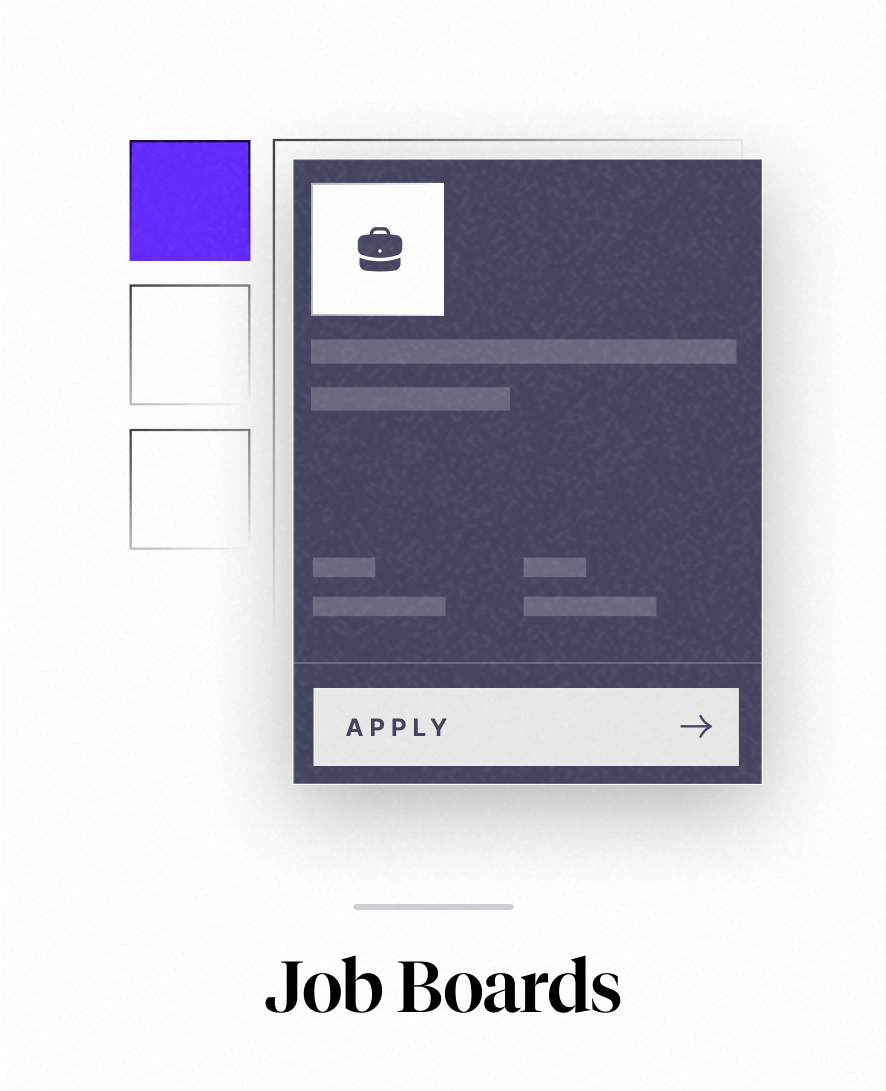Acquisition project | SQLNinja
Elevator Pitch
Imagine having an SQL AI tutor at your fingertips to guide you through all the tough spots with a personalized learning path. The AI tutor just not unblocks you but also, tells you what exactly you need to do to go to the next level. The platform understands your career goals with SQL and assists you in achieving them faster than anywhere else in the world. In other words, we are Duolingo for learning SQL.
Understand your Product
SQLNinja is a gamified, AI-assisted SQL learning platform. It understands the user's current competency level and career goals by asking questions in the beginning and creates a tailored path for learners to teach them exactly what they need to learn in order to go to the next level.
For instance - An entry data analyst doesn't need to know advanced SQL concepts such as indexing, DDL & query optimization but a data engineer needs to know exactly that. SQLNinja takes input on career goals from users when they sign up, tests their current knowledge, and creates a personalized path that allows the user to learn SQL more efficiently than any other platform in the world.
The product is in the pre-PMF stage.
One Proof of concept is SQL Expert GPT on ChatGPT! It has 200+ Conversations, ranks #5 in programming category, and command 4.3/5 ratings with 5k+ reviewers.
What is the fundamental need or want that the product is solving for?
Creating a personalized SQL learning path with the help of AI based on the user's career goals & competency levels.
What are the basic features and functionalities that the product provides?
The core features of the products are as follows:
Tailored Learning Paths:
Based on your career goal & Gradually build up SQL skills with step-by-step concepts, ensuring a smooth progression in difficulty.
AI-Guided Learning:
Engage in conversational learning with AI-driven feedback, tailored to your understanding and needs.
Progress Tracking:
Get a snapshot of your SQL concepts understanding based on historical performance
Role-Specific Challenges:
Solve challenges relevant to your role—like retention queries for product analysts or CAC queries for marketing analysts—enhancing practical application.
Dynamic Practice Question Bank:
Receive personalized practice questions based on your past performance, reinforcing areas where you need improvement.
Interactive SQL Editor:
Start querying instantly without the need for any SQL server installation—just log in and practice.
Real-time Leaderboard:
Stay motivated with daily, weekly, and monthly leaderboards that track your progress against other learners.
Gamification:
Track your progress through streaks, points, and badges, helping you visualize your learning journey.

Daily Challenges:
Build a daily SQL habit with challenges categorized as Easy, Medium, and Hard, designed to keep you engaged and improving.
Community Interaction:
Send appreciation pings to peers who solve challenges, fostering a supportive learning community.
Modules for Quick Refreshers:
Quickly revisit key concepts with refresher modules, perfect for when you need to brush up on specific topics
Weekly Data Newsletter
: SQLNinja has a dedicated data newsletter -
DataPulse Weeklyon Substack. It has about 600 subscribers & deliver a weekly engaging newsletter to help readers build a data-driven mindset and improve their decision making skills
One-click Social Sharing
: The platform allows users to share their progress with their professional network, especially LinkedIn. The below image goes on LinkedIn with the links to the user profile that has more information about the user's past historical performance. Easy for any potential employer to find the users.
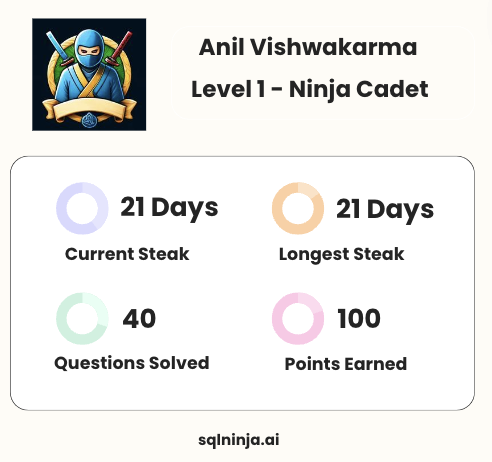
What other ways are users using to solve the same problem? If it is a new category, how else were people solving the problem?
In our user research, we found that learners often resort to a variety of generic SQL platforms, with no single platform emerging as a go-to choice. The selection of platforms heavily depends on individual user awareness and preferences.
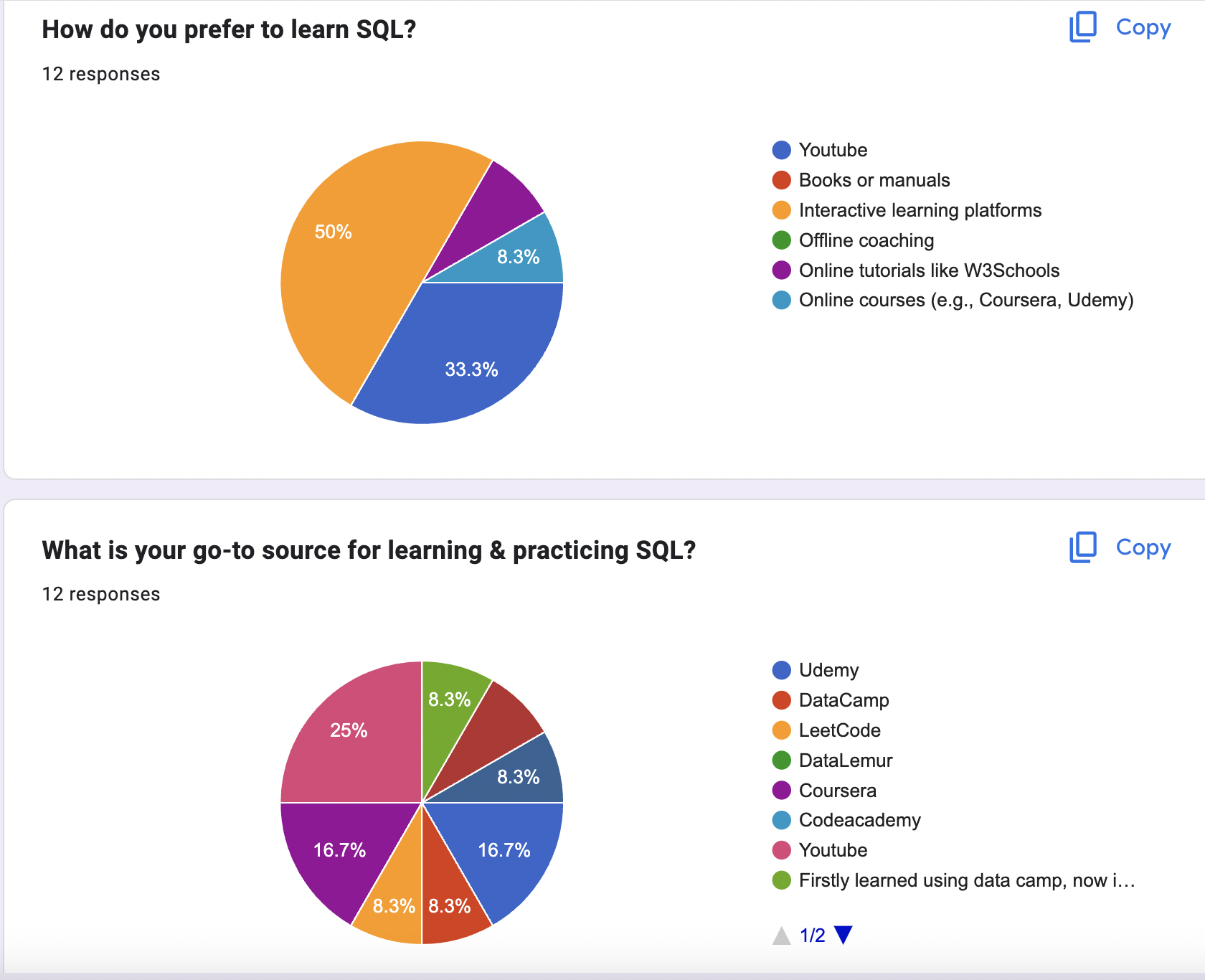
For instance -
1. Out of 12 users surveyed, they identified 8 different platforms they use to learn SQL, highlighting the fragmented landscape of SQL education. This diversity indicates that users are burdened with the task of sifting through multiple platforms to find one that meets their specific learning needs. This process can be time-consuming and overwhelming, leading to a less efficient and often frustrating learning experience.
2. One striking observation was the contrast between how users prefer to learn SQL and their actual go-to sources. While 50% of users indicated that 'Interactive Learning Platforms' are their first choice, 57% still rely on non-interactive platforms like YouTube, Coursera, and Udemy!
Understanding Core Value Proposition
TL;DR - Helps user personalize their SQL learning with the help of AI for their career goals - saves time, removes guesswork & accelerates learning.
How exactly? - SQL can be divided and learned across various concepts aligned with specific career goals. Our platform maps each user’s career goal to the appropriate SQL concepts, creating a personalized learning path. This path is guided by AI, utilizing reinforcement learning and gamification to ensure the user progresses in the right direction. The two images below illustrate the different SQL concepts and how they are mapped to various roles.
Different SQL concepts -

SQL Concepts Category mapped with Career Goals -

Step 1: Begin by asking yourself and your team about the Main Benefit
- What are you really in the business of?
We are in the business of a career-based outcome learning path for data professionals who want to enhance their SQL skills - What problem is your product or service solving for the customer?
We are removing guesswork and creating a personalized learning path for the users to do exactly what they need to do to advance their skillset in SQL. It's not just effective but efficient and saves a good amount of time in researching different platforms while making sure the user achieve their learning goals. - What are the key features and key customer benefits?
Below are the main benefits the user will receive upon using the platform. Mapping the features from the previous sections on how the user will realize those benefits - - Accelerates and personalizes user SQL learning journey
(Feature mapping: Tailored Learning Paths, AI-guided learning, Progress Tracking) - Stay motivated by tracking & comparing your progress in real time
(Feature mapping: Progress tracking, Gamification, Real-time Leaderboard) - Saves time & reduce guesswork: Forget researching about which platforms will be best for your goal. Just come, fill out the form, and get a tailored learning path for yourself
(Feature mapping: Tailored Learning Paths, Role-Specific Challenges) - Get 24x7 assistant: An AI guide is always there to help the user with any doubts
(Feature mapping: AI-guided learning) - Solve relevant challenges: A product analyst learns by solving retention problems, whereas a data engineer solves optimizing database problem
(Feature mapping: Role-Specific Challenges) - Reinforcement learning: Solify learning by automatically revisiting the difficult concepts
(Feature mapping: Dynamic Practice Question Bank, Modules for Quick Refreshers) - No need to set the SQL server. Just write queries.
(Feature mapping: Interactive SQL Editor) - Practice habits.
(Feature mapping: Daily Challenges)
- Accelerates and personalizes user SQL learning journey
Step 2: Ask your best customers about the Customer Benefits
Why the user will choose us over our competition?
While we are still in the pre-PMF stage, upon doing user research below are the reasons why the user will choose us over over our competitors:

Reason 1: Tailored Learning Paths, AI-guided learning
Customization of the learning path based on the user's career goal and competency level is a big differentiation & one of the most desirable features. "
Overwhelming abundance of SQL resources
" is one of the top challenges for the users. We take the guesswork out and outline the learning path for the user during their onboarding journey.

Reason 2: Progress tracking
One of the biggest differences is how we track the user's understanding of the concepts by looking at their historical performance. Current platforms are limited to how many questions the users have solved with Easy, Medium & Hard difficulties.

Reason 3: Gamification
While gamification was not one of the most sought-after features, this has never been tried in SQL learning. Duolingo has already proved that learning can be made fun by gamifying learning & this is another differentiation we would like to bet on.
Other questions:
Why do you keep doing business with us? Efficiency and effectiveness of the platform. Helping the user achieve the exact goals that they need to achieve.
What words would you use to describe our company? Futuristic & forward-looking
If you were referring a friend to our business, what would you tell them about us? This platform can help you learn SQL in the least possible time.
Step 3: Gather all the insights
Here are some intangible benefits that may be core value propositions for your customers:
- Save time for the user by removing the guesswork (personalization)
- Tell them what exactly they need to learn (Progress tracking)
- Keeping users motivated & excited (Gamification)
Other points:
- Video tutorials & project showcases are other most sought-after product features that users appreciate and we lack those on the platform
How are the users experiencing this core value proposition?
Journey Maps & Experience Mapping:
Create journey maps to visualize the user’s path from discovery to adoption, identifying key touchpoints and potential friction areas, this helps us to look at the process from a user point of view
Journey 1: Onboarding & realizing the core value proposition
The user learns about the platform from an existing user →
The user lands on the website →
The user is educated about the features & benefits →
Onboarding questionnaire to know the career goal of the user →
Based on the selection, the user is served with 10 multiple-choice questions to understand their current competency (The user has the option to skip & select the competency manually, not recommended though) →
A personalized learning path is created for the users based on responses →
The user needs to sign up →
Users have the option to either practice or learn →
The user starts solving the problem on the platform →
A real-time progress bar appears →
The user receives real-time feedback from an AI guide →
The user progresses in the journey to solve more problems →
AI guide changes the difficulties of the problems based on user performance →
The user gets excited about learning a new concept & feels accomplished
Journey 2: User engaging with the platform (Solving daily challenges)
The user receives an email for daily challenges with the current streak →
The user clicks on the email and login →
User solves the daily challenge →
The user receives points & progresses through the leaderboard →
Users feel motivated & accomplished
Understanding the Users: ICP
We have chosen the top 3 ICPs. There can be more ICPs.
Criteria | Final year college student - looking to get a job in the data analytics field | Analytics professional with 1-2 years of experience | Non-technical professional moving to the data analytics field with 1-2 years of experience |
|---|---|---|---|
Name | Rashi | Sandeep | Rizwan |
Age | 19-24 | 20-26 | 23-30 |
Demographics |
|
|
|
Need | Get a job | Upskill | Transition to data jobs |
Pain Point | Low pocket money, | Go deep in core data skills, Unawareness of analytics career roadmap, | Low pay in the existing jobs, |
Solution | Learn a core data skill to become employable | Learn a core data skill in-depth | Learn a core data skill to transition to data jobs |
Behavior |
|
|
|
Perceived Value of Brand | NA as the product is in early PMF | NA as the product is in early PMF | NA as the product is in early PMF |
Marketing Pitch | Learn the most important data skills - SQL with an AI tutor | Learn advanced SQL and shine at your work with SQL AI tutor | Transition to a data career by learning the most important skills - SQL with an AI tutor |
Goals | Get a decent job in the salary range of 30-100k | Get a promotion | Transition to a data job for a better career prospectus |
Frequency of use case | Daily during job placements | 2-3 times a week (mostly during the weekend) | 2-3 times a week (mostly during the weekend) |
Average Spend on the Product | 1000 INR | 3000 INR | 3000 INR |
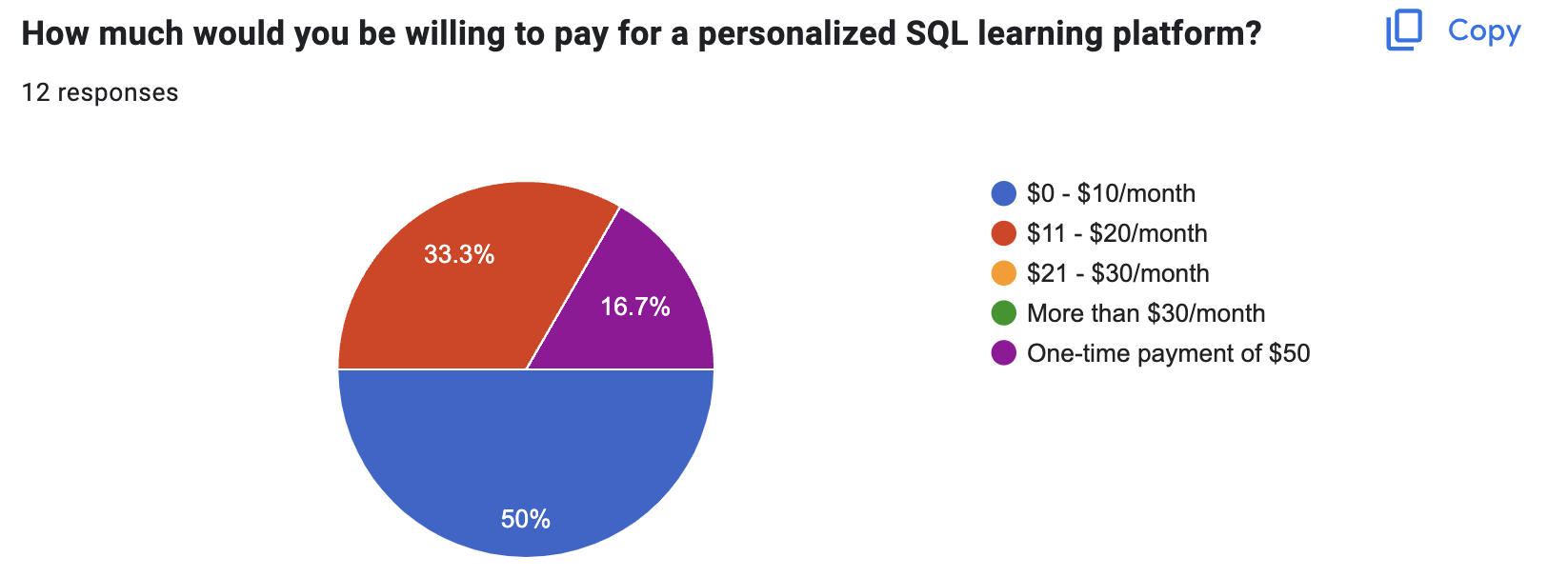
ICP prioritization table:
Criteria | Freshers | Entry-level data professional | Entry-level non-data professional |
|---|---|---|---|
Adoption Curve | High | High | Medium |
Appetite to Pay | Medium | High | High |
Frequency of Use Case | High | Medium | Medium |
Distribution Potential | High | High | Low |
TAM (Worldwide) | 15 Million | 2.3 Million | 25 Million |
Approach for TAM:
1. Freshers
- Definition: Recent graduates or individuals entering the workforce for the first time, interested in starting a career in the data industry.
- Estimated TAM:
- Global Graduates: There are approximately 150 million higher education graduates globally each year .
- Interest in Data Roles: Assuming 10% of these graduates are interested in data roles, we estimate 15 million potential users.
- TAM Estimate: 15 million potential users
2. Entry-Level Data Professionals
- Definition: Professionals with 0-2 years of experience in data-related roles.
- Estimated TAM:
- Global Data Professionals: The global data science and analytics workforce is expected to reach around 11.5 million by 2026.
- Entry-Level Proportion: Assuming that 20% of these professionals are in entry-level positions, we estimate 2.3 million potential users.
- TAM Estimate: 2.3 million potential users
3. Entry-Level Non-Data Professionals
- Definition: Professionals in other fields with 0-2 years of experience who are interested in transitioning into data roles.
- Estimated TAM:
- Global Entry-Level Workforce: The global entry-level workforce is vast, with hundreds of millions of professionals across various industries.
- Interest in Transitioning to Data: Assuming 5% of entry-level professionals globally (from a conservative estimate of 500 million entry-level professionals) are interested in transitioning to data roles, we estimate 25 million potential users.
- TAM Estimate: 25 million potential users
Total TAM Estimate
The combined TAM for all three ICPs can be considered as the sum of the individual TAM estimates:
- Total TAM: 15 million (Freshers) + 2.3 million (Entry-Level Data Professionals) + 25 million (Entry-Level Non-Data Professionals) = 42.3 million potential users
Relevant Sources for Stats:
- Global Graduates: World Bank Education Statistics
- Global Data Science Workforce: Burning Glass Technologies Report on Data Science
- Global Entry-Level Workforce: ILO Global Employment Trends
Understand Market
(begin by doing a basic competitor analysis)
Factors | DataCamp | Coursera/Udemy | Individual Trainer | DataLemur | Dataford |
|---|---|---|---|---|---|
What is the core problem being solved by them? | Interactive learning experience | Video tutorials by experts | Personalized video tutorials | Interview questions asked in FAANG | Interview & interactive learning experience |
What are the products/features/services being offered? | Interactive coding exercises, skill tracks, career tracks, projects | Video courses, specializations, certifications | Custom training sessions, 1-on-1 mentoring | FAANG-focused SQL interview questions, practice problems | SQL interview questions, interactive exercises, mock interviews |
Who are the users? | Data professionals, students, career switchers | Students, professionals, career switchers | Individuals seeking personalized training | Job seekers targeting FAANG companies | Job seekers aiming for top tech roles |
GTM Strategy | Focus on upskilling for data roles, partnerships with universities and companies | Massive online presence, partnerships with universities | Word of mouth, local advertising | Niche focus on FAANG aspirants, content marketing | Targeted towards tech job aspirants, leveraging content marketing |
What channels do they use? | Social media, online ads, email marketing, partnerships | Social media, SEO, content marketing, partnerships | Social media, referrals, personal network | Social media, blog posts, forums | Social media, SEO, blogs, forums |
What pricing model do they operate on? | Subscription-based, with free trial | One-time payment per course, subscription options for some courses | Pay-per-session or package pricing | Free tier with paid premium options | Free content with paid premium features |
How have they raised funding? | Venture capital, private equity | Acquisitions, corporate partnerships, venture capital | Self-funded or small private investments | Bootstrapped, possibly angel investment | Bootstrapped, private funding |
Brand Positioning | Leading platform for data science learning | Trusted source for a wide range of online courses | Personalized, flexible learning | Go-to for FAANG SQL interview prep | Comprehensive prep for top tech interviews |
UX Evaluation | User-friendly, interactive, gamified elements | Standardized, consistent, sometimes non-interactive | Highly variable, dependent on individual trainer | Focused and functional, but with limited features | Balanced between interactivity and content depth |
What is your product’s Right to Win? | Comprehensive, self-paced learning with instant feedback | Wide range of courses, recognized certifications | Highly personalized, focused learning | Specialized FAANG preparation, niche expertise | Strong focus on both interviews and interactive learning |
What can you learn from them? | The power of interactive learning and gamification | The importance of content variety and certification | The value of personalized learning experiences | Niche targeting and specialization | Combining interactivity with interview preparation to offer a holistic experience |
Now it’s time for some math, calculate the size of your market.
TAM = Total no. of potential customers x Average Revenue Per Customer (ARPU)
SAM = TAM x Target Market Segment (percentage of the total market)
SOM = SAM x Market Penetration/Share
Taking a top-down approach to this. Since we have already identified the total TAM for our 3 core ICPs
- TAM (Total Addressable Market):
- 42.3 million potential users x $20 ARPU = $846 million
- SAM (Serviceable Available Market):
- 10% of TAM = $84.6 million
- SOM (Serviceable Obtainable Market):
- 5% of SAM = $4.23 million
Here is our marketing pitch for different ICPs -
Criteria | Final year college student - looking to get a job in the data analytics field | Analytics professional with 1-2 years of experience | Non-technical professional moving to the data analytics field with 1-2 years of experience |
|---|---|---|---|
Marketing Pitch | Learn the most important data skills - SQL with an AI tutor | Learn advanced SQL and shine at your work with SQL AI tutor | Transition to a data career by learning the most important skills - SQL with SQL AI tutor |
Let's look at JTBD for our one ICP - Final year college student:
| Job | Goal |
| Functional | Learn one core technical skill to solve data-related problems |
| Personal | Become a better data professional |
| Financial | Get placed in a job with a decent pay scale. |
| Social | I want to be in the company of friends who will be placed directly from the college. My family will feel proud to see me secure a job after my college studies. |
Designing Acquisition Channel
(keep in mind the stage of your company before choosing your channels for acquisition.)
Since our stage of the company is in Product Market Fit, we will be focusing on these 3 key levers -
Cheaper, Faster & Feedback Driven.
Our goal is to find the right combination of the right marketing pitch and the ideal customer profile. With that in mind, we are adding 1 channel as an existing substack newsletter to covert some of the existing readers on the platform.
Let's look at the decision framework below.
Channel Name | Cost | Flexibility | Effort | Speed | Scale | Budget |
|---|---|---|---|---|---|---|
Organic - Reddit Community | Low | High | Medium | Medium | Medium | Low |
Substack Community | Low | High | Low | Low | Low | Low |
Paid Ads | High | High | High | High | High | High |
Referral Program | High | Low | High | Medium | Low | High |
Product Integration | High | Low | High | Low | Low | High |
Content Loops | Low | Medium | Low | Medium | Medium | Low |
We choose 3 channels: Organic - Reddit & Content Loops, Substack Community
Reason: These channels are cost-effective, easy to implement & have a huge feedback-driven community.
We are keeping ICP 1 - Final year college students to design the below experiments.
Organic - Reddit community
Below are the 2 experiments that we will run on Reddit to acquire the first set of users:
Experiment 1: Answer every single question related to SQL learning in a meaningful way
Reddit also has multiple data channels where these users ask about how to learn SQL. By meaningfully engaging in the comments on this data channels, we can redirect some of the traffic to our website. Here are some of the examples of questions asked:
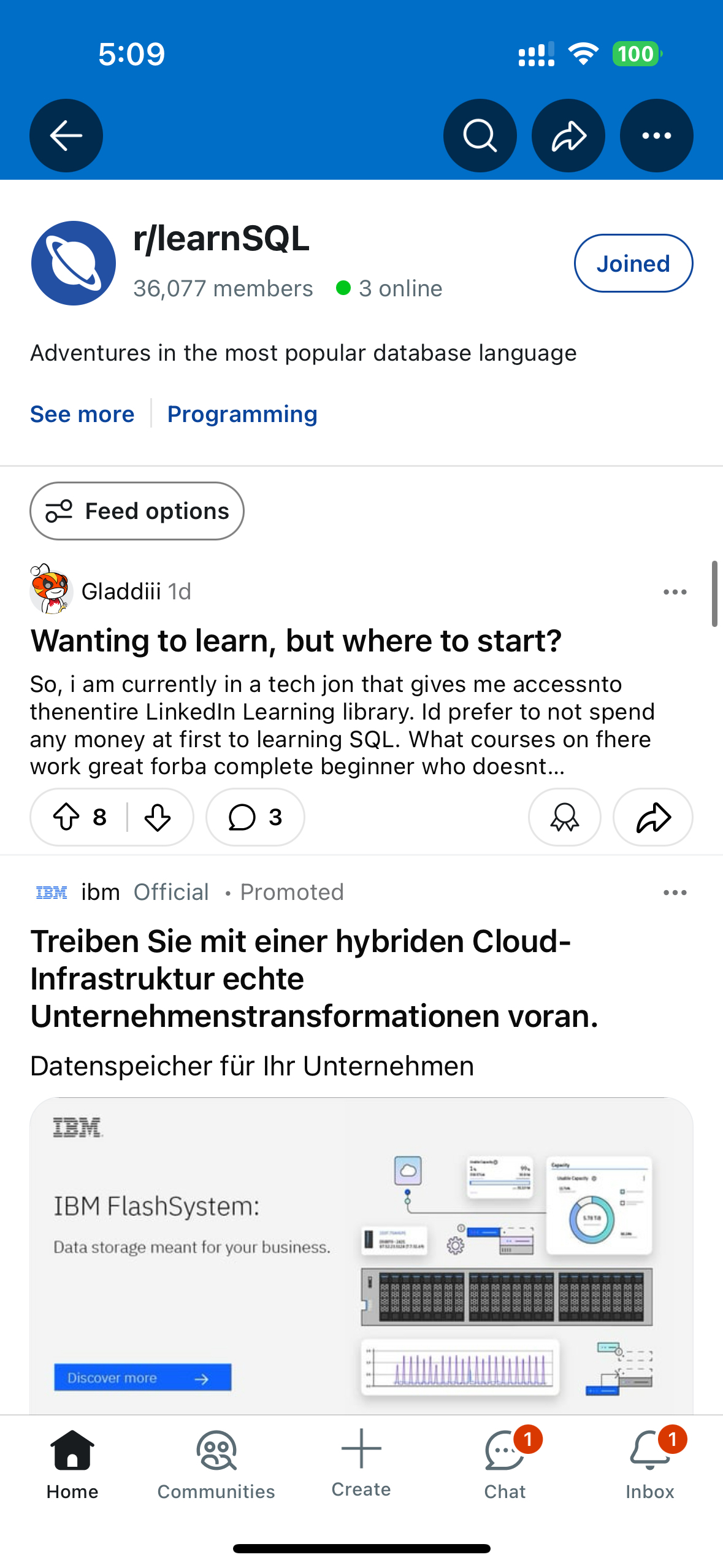
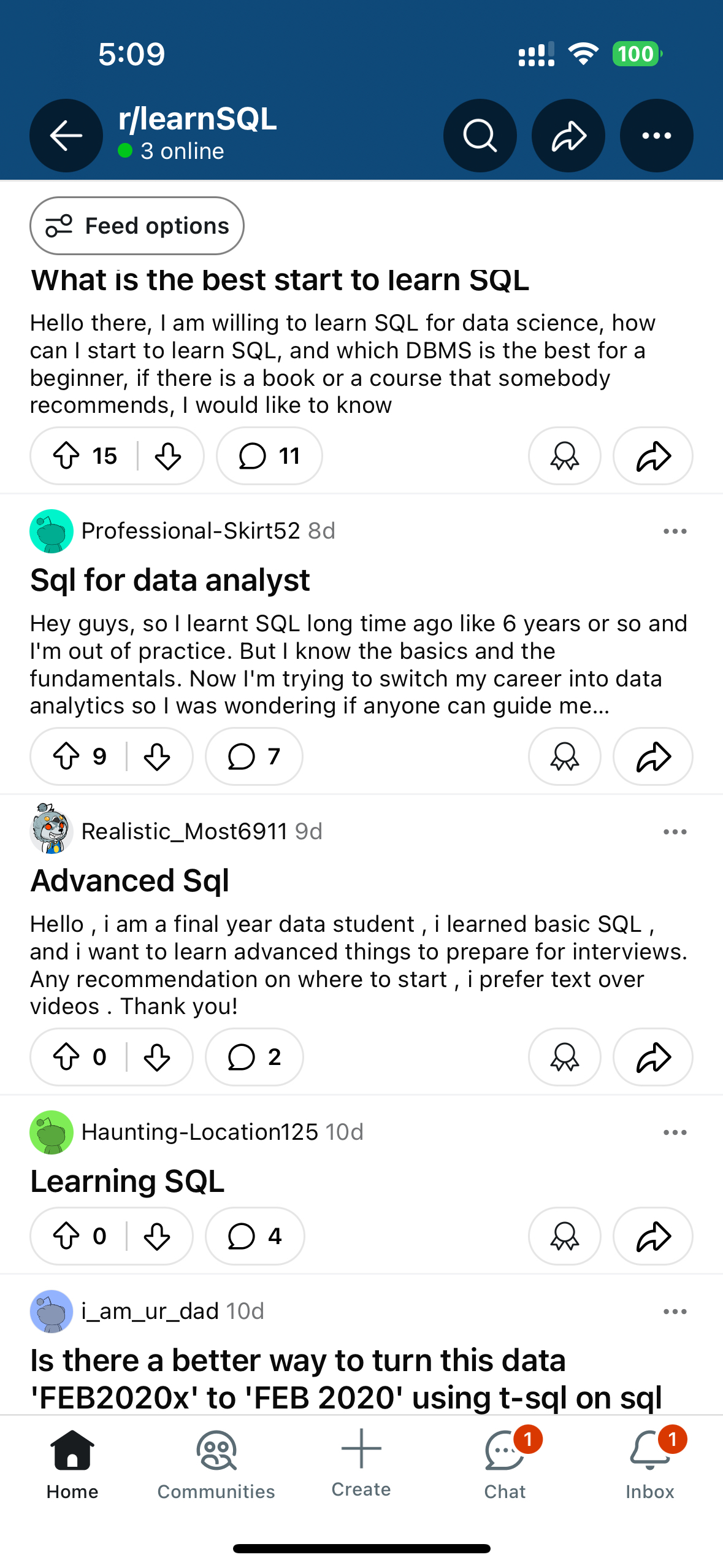
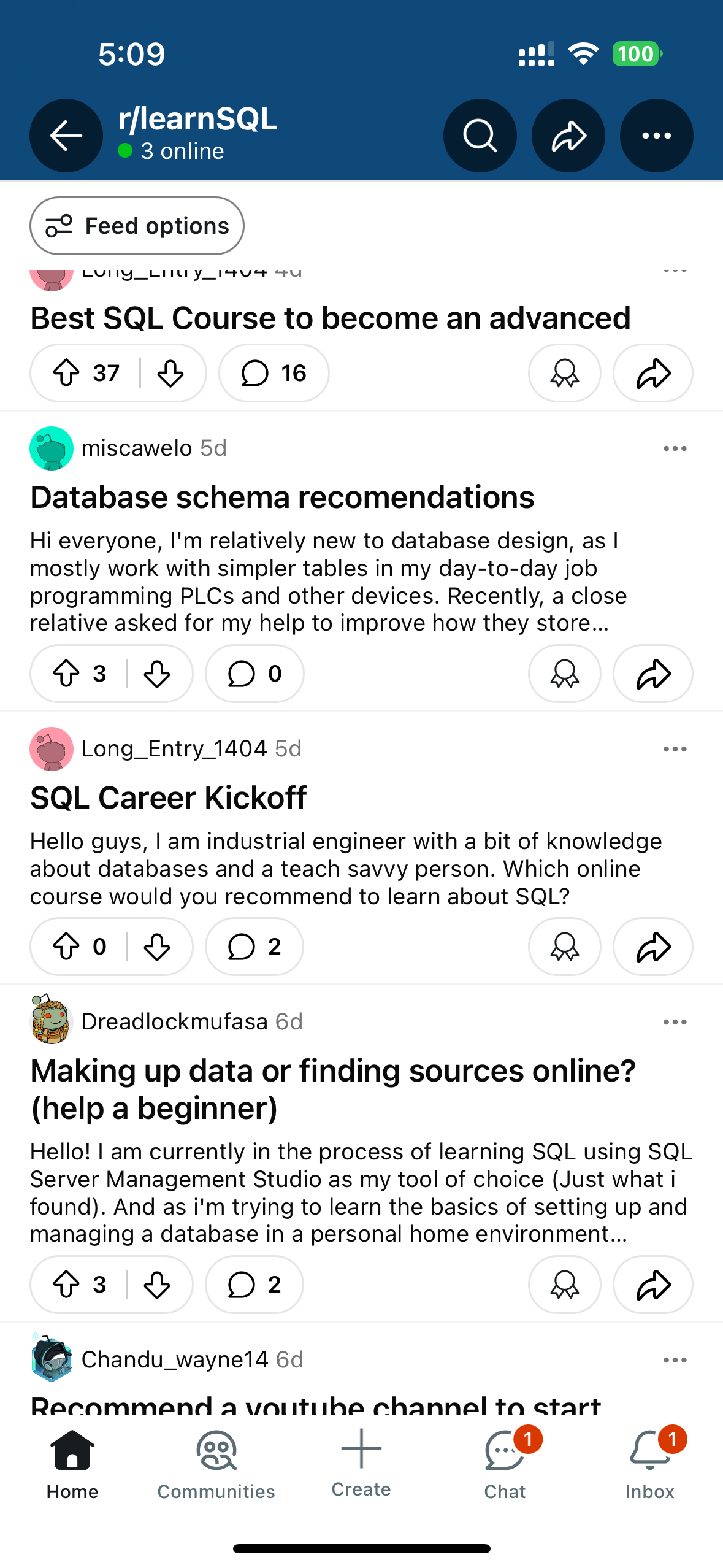
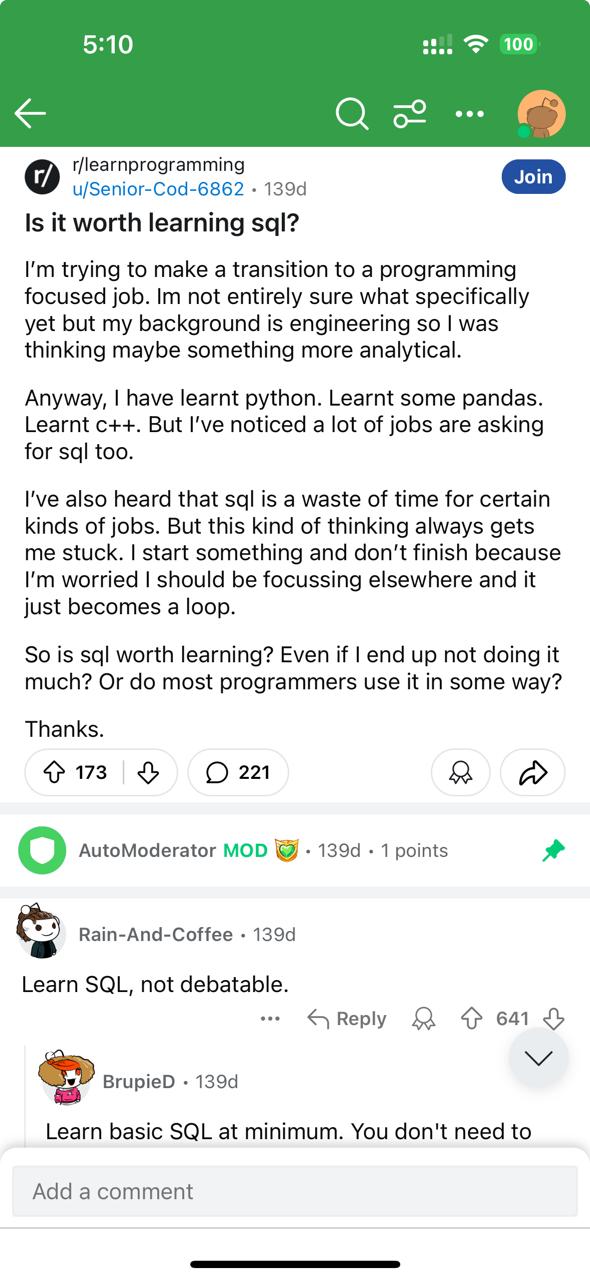
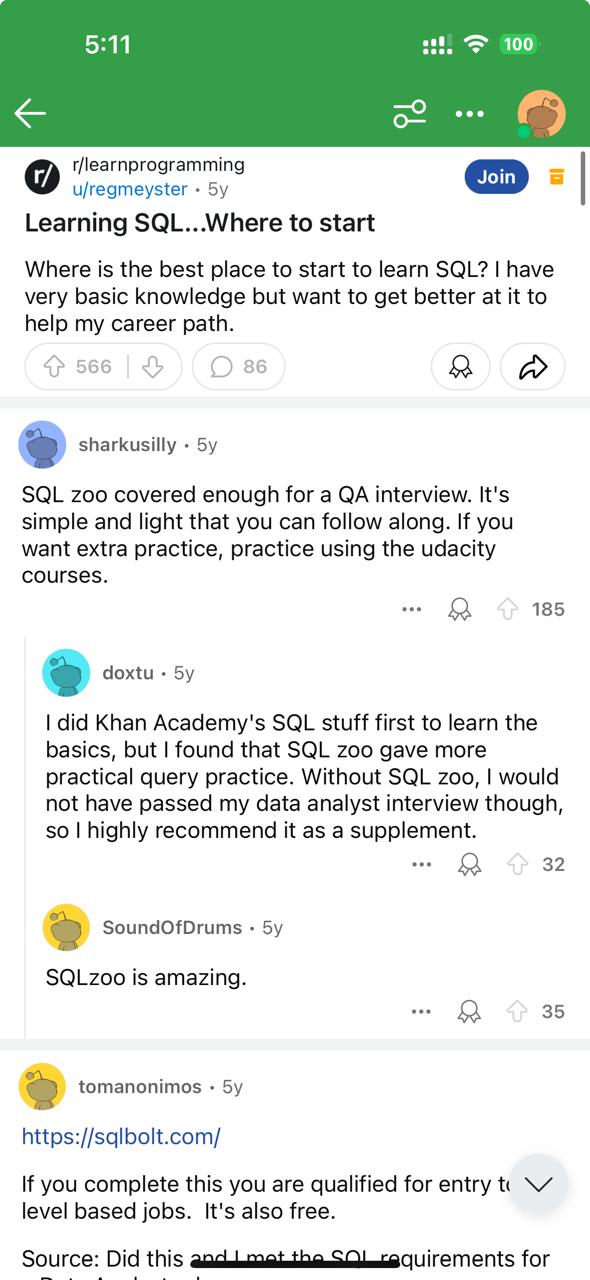
Sharing relevant answers and our core value proposition in the answers will help us to build credibility and get some of the users to convert to our platform.
Experiment 2: Call for Beta Testers: Join SQLNinja’s Exclusive Beta Program!
Below is the template to start asking users for free access to the platform & getting their feedback in return to improve the product.
"
Hello SQLNinja Community!
We’re excited to announce that SQLNinja is looking for beta testers to help us refine and perfect our platform. If you’re a final-year college student or an entry-level fresher eager to upskill for your career, this opportunity is for you!
What’s in it for you?
- Exclusive Early Access: Be among the first to experience our cutting-edge SQL learning platform.
- Hands-On Learning: Get access to all our tailored daily challenges, interactive modules, and practice questions designed to boost your SQL skills.
- Direct Feedback Loop: Your insights and feedback will directly influence the development and enhancement of SQLNinja.
- Career Boost: Enhance your SQL proficiency, making you a more competitive candidate in the job market.
- Recognition: As a thank you, you’ll receive a special badge on our platform that recognizes your contributions as a beta tester.
Who Are We Looking For?
- Final Year College Students: Prepare for your career with advanced SQL skills.
- Entry-Level Freshers: Upskill and stand out in the job market with practical SQL knowledge.
How to Apply?
If you’re interested in being part of our beta testing program, please fill out the attached form. We’ll be selecting 20 enthusiastic and serious candidates to join our exclusive beta tester group.
Fill Out the Beta Tester Application Form
What We Expect from Beta Testers:
- Active Participation: Engage with the platform regularly and complete daily challenges and modules.
- Provide Feedback: Share your thoughts, suggestions, and any issues you encounter to help us improve the platform.
- Spread the Word: Help us build a vibrant community by sharing your experiences with SQLNinja on social media and with your peers.
Don’t miss this chance to be a key player in shaping the future of SQL learning. Apply now and take your SQL skills to the next level with SQLNinja!
We can’t wait to work with you!
"
Experiment 3: Leveraging Existing Substack Community (600 readers)
SQLNinja also has a data newsletter - DataPulse Weekly. It has about 600 subscribers. They send a weekly newsletter to these readers and the newsletter is growing with 100-200 new subscribers each month. The Close community & one-on-one message feature on the substack can help in taking feedback from the community at a faster rate at a low cost. By plugging in SQLNinja in the newsletter, we can convert some of the readers into SQLNinja users.
One last acquisition channel is content loops. While the content loops are not recommended in the PMF stage, we found that SQLNinja has a unique content loop that can increase the virality factor of the platforms: One-click Social Sharing.
Experiment 4: Free SQL Interview Cheatsheets
By developing free SQL Interview cheatsheets and liking them on SQLNinja social media pages, we can build other email lists that can later be leveraged on educational email journeys to convert them on SQLNinja later.
One last acquisition channel is content loops. While the content loops are not recommended in the PMF stage, we found that SQLNinja has a unique content loop that can increase the virality factor of the platforms: One-click Social Sharing.
Content Loop: One-click Social Sharing
Step 1 → Nail down your content creator, content distributor, and your channel of distribution
Content creator - Company
Content distributor - User
Channe of distribution - Linkedin & other platforms.
Step 2 → Decide which type of loop you want to build out.
Hook: The company generates a visually compelling progress image that showcases users' consistency and problem-solving achievements, serving as a powerful signal to potential employers and peers about their dedicated efforts to master SQL
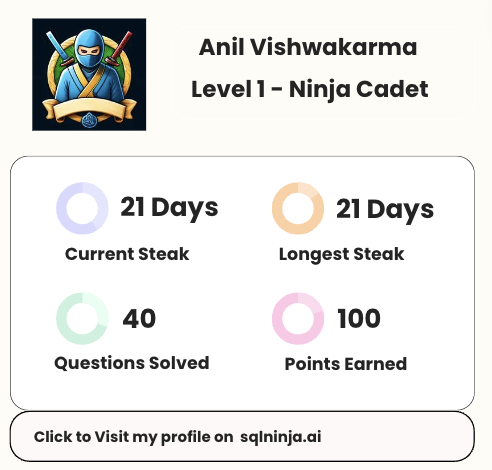
Step 3 → Create a simple flow diagram to represent the content loop.
- Users solve the SQL challenges & maintain continuous steak ->
- The users share the branded image on their social media ->
- More people see it and they sign up for SQLNinja
and the cycle repeats!
Thank you!
Brand focused courses
Great brands aren't built on clicks. They're built on trust. Craft narratives that resonate, campaigns that stand out, and brands that last.
All courses
Master every lever of growth — from acquisition to retention, data to events. Pick a course, go deep, and apply it to your business right away.
Explore courses by GrowthX
Built by Leaders From Amazon, CRED, Zepto, Hindustan Unilever, Flipkart, paytm & more
Course
Advanced Growth Strategy
Core principles to distribution, user onboarding, retention & monetisation.
58 modules
21 hours
Course
Go to Market
Learn to implement lean, balanced & all out GTM strategies while getting stakeholder buy-in.
17 modules
1 hour
Course
Brand Led Growth
Design your brand wedge & implement it across every customer touchpoint.
15 modules
2 hours
Course
Event Led Growth
Design an end to end strategy to create events that drive revenue growth.
48 modules
1 hour
Course
Growth Model Design
Learn how to break down your North Star metric into actionable input levers and prioritise them.
9 modules
1 hour
Course
Building Growth Teams
Learn how to design your team blueprint, attract, hire & retain great talent
24 modules
1 hour
Course
Data Led Growth
Learn the science of RCA & experimentation design to drive real revenue impact.
12 modules
2 hours
Course
Email marketing
Learn how to set up email as a channel and build the 0 → 1 strategy for email marketing
12 modules
1 hour
Course
Partnership Led Growth
Design product integrations & channel partnerships to drive revenue impact.
27 modules
1 hour
Course
Tech for Growth
Learn to ship better products with engineering & take informed trade-offs.
14 modules
2 hours
Crack a new job or a promotion with ELEVATE
Designed for mid-senior & leadership roles across growth, product, marketing, strategy & business
Learning Resources
Browse 500+ case studies, articles & resources the learning resources that you won't find on the internet.
Patience—you’re about to be impressed.











